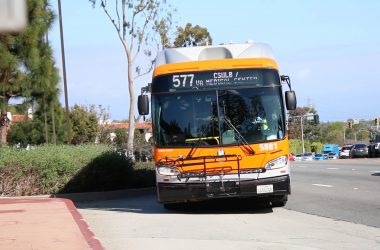Long Beach City Council approved a $4.1 million four-year study of the Long Beach breakwater, with hopes of possible reconfiguration to the wave-blocking structure. The study will explore the possibility of reconfiguring the breakwater and provide potential construction costs.
“This is just one step closer to bringing the real beach back,” said Emiko Innes, chair of the Long Beach chapter of the Surfrider Foundation. Innes was one of many that turned out in support of the study.
The Army Corps of Engineers will contribute another $4.1 million to the study, bringing the total study cost funds to about $8.3 million.
The Corps built the breakwater during World War II and completed the breakwater in 1949. The Corps maintains jurisdiction over the breakwater and because of this Long Beach has been unable to reconfigure or remove the rocky obstruction.
Though public support for the study was high, not all approved the study.
“This is the wrong time to spend $4 million on a study,” said Long Beach Chamber of Commerce President and CEO Randy Gordon. “The chamber does not have an opinion on the breakwater but the quality of life of our citizens is our top priority.”
Gordon went on to say that the study was “the wrong idea at the wrong time.”
In 2007 Moffatt and Nichol, an independent engineering organization, was selected to study the breakwater and find potential benefits for its removal. The study found that potential benefits to reconfiguring the breakwater included: an additional $3 million beachgoers annually, $27 million in federal recreation benefits, and $52 million in annual spending increases.
“If we don’t act in a certain amount of time, the study goes stale,” said councilmember Patrick O’Donnell, who has been a big supporter of the study. “Tonight is about clean water, more waves and a better economy.”
Manager of Government Affairs Tom Modica outlined the Army Corps timeline.
“There will be a minimum four-year feasibility study, which may be extended due to funding or scope,” Modica said. “Then an additional two-to-three years for design then construction, which will depend on project scope.”
Innes explains that the approval of the study was just one phase to the ultimate goal of reconfiguring the breakwater.
“We need community pressure on this project,” Innes said. “We need constant pressure so that the Army Corps finishes on time and doesn’t spend more money. We’re going to keep asking them, ‘Where’s the study?’ “
No schedule for the study has been released.
Disclaimer: The Daily 49er is not responsible for Postingsmade on www.daily49er.wpengine.com.Persons commenting are solely responsible for Postings made on thiswebsite. Persons commenting agree to the Terms of Use of the website.If Postings do not abide by the Rules of Conduct or PostingRegulations as listed in the




